Related Research Articles

Quintus Fabius Maximus Verrucosus, surnamed Cunctator, was a Roman statesman and general of the third century BC. He was consul five times and was appointed dictator in 221 and 217 BC. He was censor in 230 BC. His agnomen, Cunctator, usually translated as "the delayer", refers to the strategy that he employed against Hannibal's forces during the Second Punic War. Facing an outstanding commander with superior numbers, he pursued a then-novel strategy of targeting the enemy's supply lines, and accepting only smaller engagements on favourable ground, rather than risking his entire army on direct confrontation with Hannibal himself. As a result, he is regarded as the originator of many tactics used in guerrilla warfare.
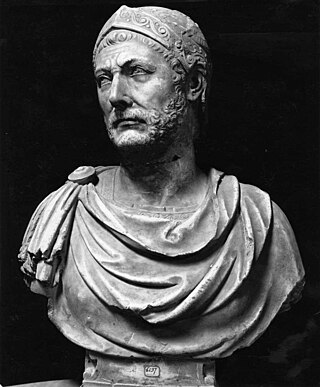
Hannibal was a Carthaginian general and statesman who commanded the forces of Carthage in their battle against the Roman Republic during the Second Punic War.

The Appian Way is one of the earliest and strategically most important Roman roads of the ancient republic. It connected Rome to Brindisi, in southeast Italy. Its importance is indicated by its common name, recorded by Statius, of Appia longarum... regina viarum . The road is named after Appius Claudius Caecus, the Roman censor who, during the Samnite Wars, began and completed the first section as a military road to the south in 312 BC.
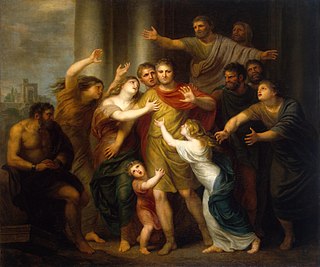
The gens Atilia, sometimes written Atillia, was a plebeian family at ancient Rome, which rose to prominence at the beginning of the fourth century BC. The first member of this gens to attain the consulship was Marcus Atilius Regulus, in 335 BC. The Atilii continued to hold the highest offices of the state throughout the history of the Republic, and well into imperial times.

The Porta Capena was a gate in the Servian Wall in Rome, Italy. The gate was located in the area of Piazza di Porta Capena, where the Caelian, Palatine and Aventine hills meet. Probably its exact position was between the entrance of Via di Valle delle Camene and the beginning of Via delle Terme di Caracalla, facing the curved side of the Circus Maximus.

The Caelian Hill is one of the famous seven hills of Rome.
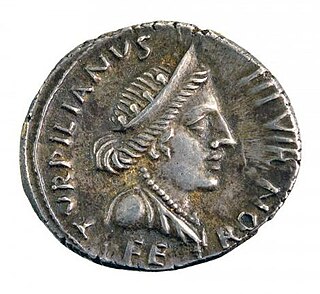
In Etruscan and Sabine religion, Feronia was a goddess associated with wildlife, fertility, health, and abundance, also venerated by the Faliscans and later adopted into ancient Roman religion. As the goddess who granted freedom to slaves or civil rights to the most humble part of society, she was especially honored among plebeians and freedmen. Her festival, the Feroniae, was November 13 during the Ludi Plebeii, in conjunction with Fortuna Primigenia; both were goddesses of Praeneste.

Herodes Atticus was an Athenian rhetorician, as well as a Roman senator. A great philanthropic magnate, he and his wife Appia Annia Regilla, for whose murder he was potentially responsible, commissioned many Athenian public works, several of which stand to the present day. He was one of the best-known figures of the Antonine Period, and taught rhetoric to the Roman emperors Marcus Aurelius and Lucius Verus, and was advanced to the consulship in 143. His full name as a Roman citizen was Lucius Vibullius Hipparchus Tiberius Claudius Atticus Herodes.

Lucus Feroniae was an ancient sanctuary or, literally sacred grove ("lucus"), dedicated to the Sabine goddess Feronia, protector of freedmen, ex-slaves. It was located near to the ancient town of Feronia in Etruria on the ancient Via Tiberina, in what is now the territory of the modern commune of Capena, Lazio.
Libyssa or Libysa (Λίβισσα), was a town on the north coast of the Sinus Astacenus in ancient Bithynia, on the road from Nicaea to Chalcedon. It was celebrated in antiquity as the place containing the tomb of the Carthaginian general Hannibal. In Pliny the Elder's time the town no longer existed, but the spot was noticed only because of the tumulus of Hannibal.
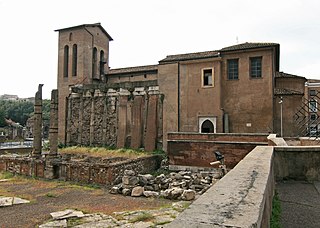
The Temple of Janus at the Forum Holitorium was a Roman temple dedicated to the god Janus, located between the Capitoline Hill and the Tiber River near the Circus Flaminius in the southern Campus Martius. The temple was built during the First Punic War, after the Temple of Janus in the Roman Forum.
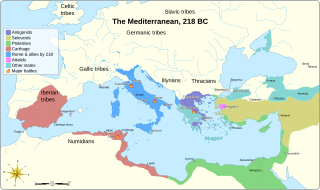
The Battle of Insubria in 203 BC was the culmination of a major war, carried out by the Carthaginian commander Mago, brother of Hannibal Barca, at the end of the Second Punic war between Rome and Carthage in what is now northwestern Italy. Mago had landed at Genoa, Liguria, two years before, in an effort to keep the Romans busy to the North and thus hamper indirectly their plans to invade Carthage's hinterland in Africa. He was quite successful in reigniting the unrest among various peoples against the Roman dominance. Rome was forced to concentrate large forces against him which finally resulted in a battle fought in the land of the Insubres (Lombardy). Mago suffered defeat and had to retreat. The strategy to divert the enemy's forces failed as the Roman general Publius Cornelius Scipio laid waste to Africa and wiped out the Carthaginian armies that were sent to destroy the invader. To counter Scipio, the Carthaginian government recalled Mago from Italy. However, the remnants of the Carthaginian forces in Cisalpine Gaul continued to harass the Romans for several years after the end of the war.
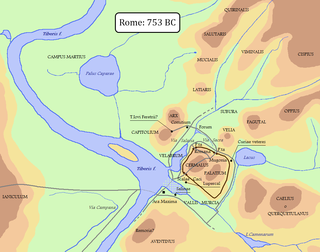
Arx is a Latin word meaning "citadel". In the ancient city of Rome, the arx was located on the northern spur of the Capitoline Hill, and is sometimes specified as the Arx Capitolina.

Appia Annia Regilla, full name Appia Annia Regilla Atilia Caucidia Tertulla, was a wealthy, aristocratic and influential Roman woman, who was a distant relative of several Roman emperors and empresses. She was the wife of the prominent Greek Herodes Atticus.

The Caffarella Park is a large park in Rome, Italy, protected from development. It is part of the Parco Regionale Appia Antica. The park is contained in the Caffarella Valley and is bordered on its northern side by the Via Latina and on its southern by the Appian Way. It stretches from the main Rome-Pisa railroad tracks near the Aurelian Wall at its western edge to the Via dell'Almone to the east. It contains several sites of archaeological interest, as well as a working farm, and has considerable ecological value, with 78 species of birds and fauna. The Catacombs of Rome and Colli Albani are nearby.

The Tomb of the Scipios, also called the hypogaeum Scipionum, was the common tomb of the patrician Scipio family during the Roman Republic for interments between the early 3rd century BC and the early 1st century AD. Then it was abandoned and within a few hundred years its location was lost.

The Porta Querquetulana or Querquetularia was a gateway in the Servian Wall, named after the sacred grove of the Querquetulanae adjacent to and just within it. The grove appears not to have still existed in the latter first century BC.

The Regio I Porta Capena is the first regio of imperial Rome, under Augustus's administrative reform. Regio I took its name from the Porta Capena, a gate of the Servian Walls, through which the Appian Way entered the city prior to the construction of the Aurelian Walls.
The Temple of Honor and Virtue was a temple in Regio I of ancient Rome dedicated to Virtus and Honos. No remains survive. It is the first entry for Regio I in the regional catalogues and was sited just outside the porta Capena, probably on the northern side of the via Appia. In front of it was the Ara Fortuna Redux.
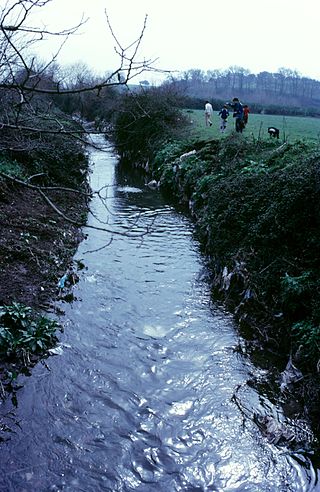
The Almone is a small river of the Ager Romanus, a few miles south of the city of Rome. Today the river is polluted and is channelled to a sewage treatment plant and no longer reaches its natural confluence with the Tiber.
References
- ↑ "Rediculus". Myth Index. 2008. Retrieved May 21, 2011.
- ↑ Adkins, Lesley; Roy A. Adkins (2004). Handbook to Life in Ancient Rome. Infobase Publishing. p. 301. ISBN 9780816074822.
- 1 2 3 Sale, George; et al. (1747). An Universal History. Vol. XII. London: T. Osborne. pp. 299–300.
- ↑ Harrington, Karl Pomeroy (2002). The Roman Elegiac Poets. Anthem Classics. p. 278.
- ↑ John, Bostock; Henry Thomas Riley (1855). The Natural History of Pliny. Vol. 2. London: Henry G. Bohn. p. 525. ISBN 9780598910769.
- ↑ Eaton, Charlotte (1892). Rome in the Nineteenth Century. Vol. I. London: George Bell & Sons. p. 387.
- ↑ Mommsen, Theodor (1873). William P. Dickson (ed.). The History of Rome. Vol. II. Scribner, Armstrong, & Co. p. 202.
- ↑ Burn, Robert (1871). Rome and the Campagna. Cambridge: Deighton, Bell and Co. p. 432.
- ↑ Pomeroy, Sarah (2007). The Murder of Regilla. Harvard University Press. p. 156. ISBN 9780674042209.
- 1 2 3 4 Hare, Augustus (1905). Walks in Rome (17 ed.). London: Kegan Paul, Trench, Truebner & Co. p. 291.